 |
|

|
 |
TABLE of CONTENTS
 |
Red Wing’s Main Street project graced by cooperation, collaboration, communication |
By Mike Dougherty, District 6 public affairs coordinator
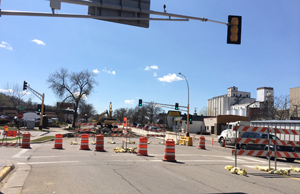
Downtown Red Wing on Highway 61 is undergoing a two-year $9.7 million reconstruction. It's a project that's started well with cooperation, collaboration and communication. Photo by Mike Dougherty |
The initial idea from city leaders for Hwy 61 in Red Wing was to make it easier for pedestrians in its historic downtown to find safer ways to cross the road and get to the riverfront area of the Mississippi River.
“From there, the idea grew as we talked more and had good discussions with MnDOT,” said Jay Owens, city engineer for Red Wing.
What it turned into was a total reconstruction of the city’s Main Street, a project that is fraught with risk and disruption, but also promises great improvements for a city that wants to welcome its many visitors.
The formal kickoff for the $9.7 million project was celebrated May 4 in Red Wing. The two-year project will result in road reconstruction, utility improvements, traffic signal upgrades, and improvements for pedestrians. About 35 community leaders attended the outdoor groundbreaking event.
“The public participation in a project of this size was huge,” said Patty Brown, executive director of the Red Wing Area Chamber of Commerce. “This is truly Red Wing’s project.”
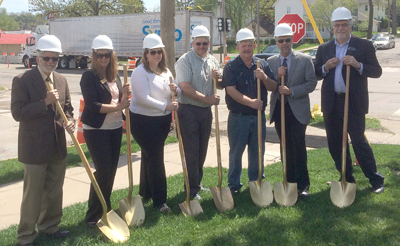
Participating in the groundbreaking ceremony for the Hwy 61 project in Red Wing were (from left) Mayor Dan Bender; Bree Maki, Sen. Al Franken’s office; Brooke Schaeffer, Rep. John Kline’s office; Brad Anderson, Goodhue County Board; Dean Hove, Red Wing City Council president; Jeff Vlaminck, district engineer for District 6, and Chuck Ackman, Sen. Amy Klobuchar’s office. Photo by Mike Dougherty |
The project will span two years to ensure that some of Red Wing’s heaviest visitor times in the fall will not be disrupted. The roadway sees an average daily traffic of about 23,000 vehicles. It will wrap up in August and resume in 2016 with completion by August 2016.
Art Owen of the Prairie Island Indian Community was a guest at the event and provided words and song for a good project. Owen asked for good health for all the workers, the weather and the ground, while singing a Native American song with his wife, Carrie.
“This is a perfect example of what can happen when MnDOT, the city and the community work together to develop and build a project," said District 6 Engineer Jeff Vlaminck. "It really is a model for how we wish all projects would go.”
A group of business and community organizations and individuals was created in advance of the project to communicate and aid businesses during the project. It’s been funded by more than $90,000 in private community foundation dollars and other local funds to help in the outreach. The group calls itself The Main Event and MnDOT has participated in its efforts.
“This project will help transform the Red Wing community, make it easier to navigate, safer, more beautiful, and usher in a new era of progress and vitality,” Brown said.
To learn more, go to www.red-wing.org/mainevent.html.
|
 |
|

|
 |
TABLE of CONTENTS
 |
Toward Zero Deaths workshops expand to all districts |
By Sue Roe
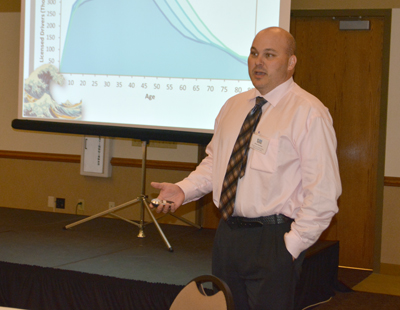
Brad Estochen, traffic safety engineer, talks about older drivers during a breakout session at the Southeast TZD Regional Workshop in Rochester May 7. Estochen talked about the challenges and opportunities for assisting the aging population and what resources are available to them in communities. Photo by Sue Roe |
Toward Zero Deaths regional workshops are underway this month and into early June. This year, all eight MnDOT districts are hosting workshops, with the Metro District’s inaugural one June 5. Regional TZD partnerships hold the annual workshops to help implement TZD in their local communities.
Workshop goals are to encourage traffic safety as a priority for policymakers, provide a method to bring traffic safety programs into local communities, spread the successes of the TZD program, and offer a networking opportunity for traffic safety advocates.
About 200 participants from cities, counties, state agencies and law enforcement attended the 11th annual Southeast Regional Workshop May 7 in Rochester.
“The workshop helps facilitate the implementation of TZD in all southeast Minnesota communities,” said Jessica Schleck, Southeast Minnesota Regional TZD coordinator. “The record attendance shows how the region is dedicated to making traffic safety programs work to reduce fatalities and injuries.”
Jeff Vlaminck, District 6 engineer, told the group that the statewide goal is fewer than 300 traffic-related fatalities and fewer than 850 serious injuries by 2020.
Presentations included:
- Best practices for improving roadway safety from an engineer’s perspective, including alternate interchange types, zipper merge, mumble/rumble strips and stopped traffic ahead warning systems.
- Crash avoidance technology and their shortcomings, including adaptive headlights, lane departure warning systems, blind spot monitoring system, electronic stability control and adaptive cruise control.
- Legislative gains to improve traffic safety, including passage of stronger state Graduated Driver Licensing requirements and an increase in speeding fines through work zones.
- Regional TZD crash facts overview, including that one county in the region had no fatalities in 2014 and another county had one.
- Legalization of medical marijuana and the impact on road safety.
- The sister of a young woman and her son who were seriously injured, and a nephew, who died after being hit by a drunk driver, spoke about the family’s loss.
In breakout sessions, participants heard about ignition interlocks, innovative strategies to address traffic safety issues such as older drivers, Safe Routes to School and motorcycle safety, roadside safety, and emergency management for first on the scene.
Read more about the TZD program or the regional workshops at www.minnesotatzd.org. The state workshop will be Oct. 29-30 in St. Cloud.
The TZD program was created in 2003 by MnDOT, the Minnesota departments of Public Safety and Health. Its mission is to create a culture for which traffic fatalities and serious injuries are no longer acceptable through the integrated application of education, engineering, enforcement, and emergency medical and trauma services. |
 |
|

|
 |
TABLE of CONTENTS
 |
Major ramp metering upgrade reduces freeway delays |
|
By Shannon Fiecke
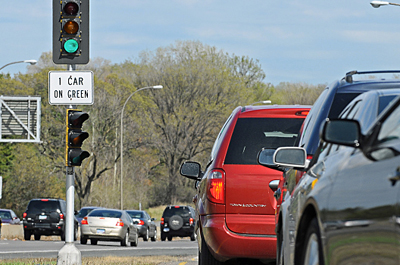
Twin Cities ramp meters now turn on and off based on live traffic conditions. Photo by Dave Gonzalez |
Motorists are experiencing less delay on metro-area highways, thanks to major changes to the Twin Cities’ ramp metering system.
MnDOT reconfigured ramp meters to be more in sync with real conditions. With changes to the turn-on and turn-off criteria, the meters are actually running for a shorter period of time and are only activated when needed.
Ramp meters are traffic lights placed on freeway entrance ramps that control the frequency that vehicles can enter the highway. Sensors embedded in the pavement collect the vehicle traffic data used to time approximately 440 ramp meters.
Staff at the Regional Transportation Management Center, which manages the ramp meters, say the whole system is operating better because of changes that were implemented last year (based off a 2012 study).
University of Minnesota-Duluth professor Eil Kwon developed the system’s new software algorithms. In a case study of Hwy 100, he found that the delay on the mainline dropped by nearly half.
On northbound Hwy 100, the amount of delayed vehicle hours — defined as the vehicle hours of traffic flow with speeds less than 45 mph — that motorists experienced, dropped 48 percent during October and November 2012 when compared to the same period in 2011. During the same time period, total volume on that section of northbound Hwy 100 increased by 2.7 percent, Kwon said. In spring 2013, the amount of delayed vehicle hours was reduced by 17 percent.
These results are preliminary, as additional analysis is needed to determine if these results are typical throughout the system on other freeway corridors. The scenario described above represents a cost savings to motorists of $1,353 to $3,447 per day (depending on the season) based on a personal savings of $16.50 per hour. That’s as much as $339,150 to $861,640 per year for just a six-mile stretch of highway.
More efficient
Under the old system, each ramp meter would turn on based on current traffic conditions; however, the criteria to turn on were easily met, causing the meters to turn on too soon. The old system did not have turn-off criteria, allowing meters to run until a pre-set time of day.
With the new system, improvements were made to make the meters respond more appropriately to current traffic conditions. The turn-on criteria were improved so that meters come on only when needed, and turn-off criteria were added, allowing meters to turn off when traffic conditions improved.
The new metering system is particularly effective at reducing the number of meters operating on light traffic days.
“On days like the ones leading up to Thanksgiving, where traffic may be 10 to 15 percent less than normal, instead of 150 ramp meters being on at a particular time, now maybe only 50 ramp meters will be operating,” said Jesse Larson, freeway system operations engineer.
Upgrades to the ramp metering system also allow for a better picture of what traffic is like at a given moment, because it’s now based on corridor density rather than traffic flow.
Traffic flow is the measurement of the number of vehicles passing a given point. Using traffic flow was flawed, because similar traffic flows can occur at different speeds. The old system couldn’t differentiate between 1,000 cars passing by at 20 miles per hour versus 1,000 cars passing at 60 miles per hour, for example.
Corridor density, on the other hand, is the number of vehicles per lane per mile. By measuring density instead of traffic flow, the system has a more accurate picture of what current conditions are like on the freeway.
An additional bonus to the program is that ramp meters will no longer release several cars simultaneously once an entrance ramp fills up. That’s because the system can now detect the ramp filling up and release the extra cars gradually instead. |
 |
|

|
 |
TABLE of CONTENTS
 |
Website connects public with answers to transportation funding questions |
|
If you’ve been following the news, you know that transportation funding is one of the hot topics being debated by the governor, legislators, transportation interest groups, chambers of commerce and others. It’s a complicated issue, and one that just about everybody has an opinion about.
The Get Connected website is one tool MnDOT is using to break down the complexities of the transportation funding debate for the general public so they, too, can be part of the conversation.
The website answers some of the most commonly asked questions the agency receives, such as:
- Where does the money for transportation come from?
- Where does the money go?
- How are construction projects selected?
- What does MnDOT spend for snow and ice removal?
|
Where does the money come from? is one of the videos found on the Get Connected website, which is intended to help answer questions about transportation funding. Video produced by Video Services |
Through the use of videos, news stories, project highlights and other tools, the website immerses users in the topic of transportation, from the size and cost of Minnesota’s transportation system, to the importance of investing in and managing transportation infrastructure, to tracking how well MnDOT is achieving its goals.
MnDOT has nearly 4,800 employees and an annual budget of almost $3 billion that is invested in building and maintaining roads and bridges, transit, rail, ports and waterways, aeronautics, and more. Of that amount, less than 3 percent covers administrative functions (e.g., information technology and human resources).
“We take stewardship of every dollar of those resources very seriously,” Tracy Hatch, deputy commissioner, chief financial officer and chief operating officer, notes in one video. “We do our best to keep our costs low, and we try very hard to find every way to be more and more efficient. And, we commit to finding additional ways to be even better stewards.”
Check out the Get Connected website at www.mndot.gov/getconnected for more information, and share the link with family and friends. |
 |
|

|
 |
TABLE of CONTENTS
 |
Doing it better together: Environmental Stewardship Conference stresses importance of public engagement |
|
By Shannon Fiecke
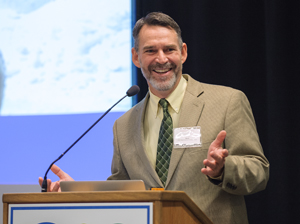
Dealing with lawmakers as head of the Utah DOT, John Njord said former Utah Governor Mike Leavitt taught him how important it is to tell people what you’re going to do – “and who you tell first matters.” Photo by David Gonzalez |
One of former Utah Department of Transportation CEO John Njord’s biggest lessons in public engagement came in the form of a howitzer.
Utah uses the military weapon for avalanche control, but instead of striking a mountainside in March 2005, DOT workers struck a house.
Rather than leave the matter to homeowner’s insurance, as advised by his risk managers, Njord decided to personally visit the home and speak with the family who lives there.
“I told them, ‘We’ll fix it. In fact, it will be better than new and it will be entirely on our bill,’ ” Njord said. “You would think a story like that would have a life of its own – but it only lasted one day.”
Njord, who led some of the most significant transportation improvements in Utah’s history, shared lessons from his 12-year career during the keynote address at MnDOT’s 2015 Environmental Stewardship Conference April 29. He and other speakers at the biennial conference, themed Do It Together—Communication, Partnerships and Results, discussed the importance of communication to a project’s success.
Before a few hundred local and state transportation practitioners, Njord shared how he used to practice “elevator speeches” to his fifth-grade son to make sure his messages were clear and easy to understand. Njord also emphasized the importance of trustworthiness, being a good listener, keeping political leaders in the loop, resolving conflict, and trusting one’s team.
“Listening is so important to what we do,” Njord said. “If you don’t listen, you can’t build allies.”
Commissioner Charlie Zelle, who was part of a MnDOT visioning committee before he was appointed commissioner, told the audience that stakeholder engagement gives people a greater sense of ownership and also mitigates future conflict and delays.
“It is my strong belief that the more time spent on public collaboration and engagement early on, is actually the most efficient thing we can do, because it saves so much in later mitigation, redesign and legal fees,” said Zelle.
Breakout sessions offered local and state transportation practitioners the chance to learn further about public engagement, as well as the latest practices in environmental stewardship and lessons from high-profile transportation projects.
Kimberly Sannes, Kimley-Horn and Associates, who moderated the session on public outreach strategies, said “outreach wasn’t even part of the conversation” when she joined MnDOT 20 years ago as a graduate engineer. “Now it’s becoming invaluable.”
These strategies include going to places where people already meet, rather than expecting the public to come to you; working with existing community organizers to reach specific neighborhoods and not wasting people’s time and expectations by collecting feedback that you aren’t going to use or consider.
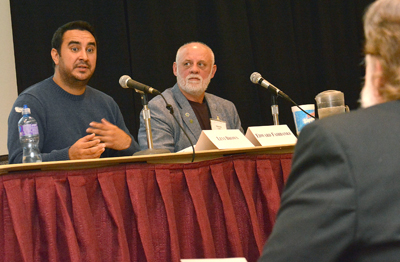
Levi Brown, Leech Lake Band of Ojibwe environmental director, and Edward Fairbanks, MnDOT tribal liaison, discussed how relationships between Indian tribes and other governmental organizations in Minnesota have improved through training and better communication. Brown and Fairbanks spoke April 29 during the Environmental Stewardship Conference. Photo by Shannon Fiecke |
During one of the breakout sessions, Levi Brown, Leech Lake Band of Ojibwe environmental director, and Edward Fairbanks, MnDOT tribal liaison, shared how increased training and communication are improving relations between Indian tribes and other governmental organizations in Minnesota. This approach speeds up the time it takes to approve infrastructure projects and reduces litigation.
“We have a county we used to sue all the time. Three years ago, we sat down with their commissioners and had coffee. A couple of them are former sheriffs and ex-deputies, and I’m a young kid from one of the roughest areas of the reservation – who would have thought?” said Brown, who is a member of Leech Lake, like Fairbanks. “We became friends and signed a memorandum of understanding. Now we build roads, infrastructure and septic systems together. We’re supposed to be doing that, instead of paying attorney’s fees. I implore you to reach out.” |
 |
|

|
 |
TABLE of CONTENTS
 |
2015 Environmental Stewardship awards are presented during conference |
By Shannon Fiecke
The 2015 MnDOT Environmental Stewardship Conference recognized several individuals and groups last month for their environmental stewardship work on transportation projects. The award recipients from MnDOT are highlighted below, as are the recipients from other agencies.
Individual Leadership Awards
Todd Clarkowski
As the MnDOT Environmental Coordination Engineer on the St. Croix Crossing Project, Todd Clarkowski has demonstrated the leadership, skills and collaborative work necessary to successfully deliver of hundreds of environmental commitments on an extremely high-profile and complex project.
Justin Knabe
Justin Knabe overcame common obstacles to accomplish early detection, eradication and control of invasive plant species along Twin Cities metro roadsides. The Metro District maintenance employee turned roadside vegetation management from a problem into a solution that serves as the first line of defense against the spread of harmful invasive plant species.
Kathryn McFadden
Despite no dedicated funds, Kathryn McFadden, Site Development Unit historic roadside properties program manager, led the rehabilitation of 11 historic roadside properties. “She has demonstrated exemplary leadership, advocacy, collaboration creativity, and proactive commitment in the stewardship, preservation and rehabilitation of Minnesota’s unrivaled collection of historic roadside properties—a unique engineering heritage,” said the conference planning committee.
Dwayne Stenlund
The Minnesota Erosion Control Association submitted Dwayne Stenlund, an internationally certified professional in erosion and sediment control, as its “off the charts” nominee. “His involvement in conferences, workshops and mentoring in the field to share his vast knowledge of products, techniques, best practices, and innovative ideas has positively affected thousands of people in the industry,” said Greg Berg, MECA President. ”
Public Engagement Award
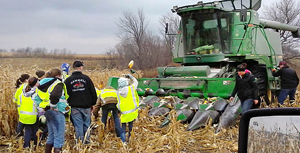
Nonprofit groups handpick corn for farmers who volunteer to be part of the standing corn row program. |
MnDOT District 6 and partners
Shannon Wait and Mike Dougherty from MnDOT District 6, and Gary Wyatt, University of Minnesota Extension, teamed up to significantly increase participation in the standing corn row program. District 6 recruited farmers in problematic areas of blowing snow and asked nonprofit groups to handpick the corn so farmers could bring in their entire fall harvest.
Award for Construction

The Hastings Bridge project was recognized for efforts in dealing with environmental challenges. |
MnDOT Metro District and partners
The innovative Hwy 61 Hastings Bridge project replacement was recognized for the broad array of environmental challenges and unique public space created. Key members of the team include Steve Kordosky, Tom Villar, Keri Aufdencamp, Craig Johnson and Dwayne Stenlund, MnDOT; Peter Leete, DNR; Todd Renville, URS; and John Phillips, Braun Intertec.
Award for Multimodal Transportation
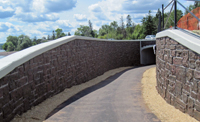
The extension of the Lake Walk along Lake Superior received an award for multimodal transportation. |
MnDOT District 1, city of Duluth and partners
This award recognized MnDOT District 1, the city of Duluth and their teams and partners for the Hwy 61 Lester River Area projects that complete the extension of Duluth’s multimodal Lake Walk to the Brighton Beach area along the shore of Lake Superior. The Lake Walk extension traverses rails, rivers, roads and sensitive cultural and natural environments in a safe, accessible, and experiential manner.

Green infrastructure elements were used in the Highway 4 reconstruction project in Cosmos to absorb and filter stormwater runoff in a natural and visually pleasing way. |
Judge’s Choice Award
District 8 and partners
District 8 received this award for the Hwy 4 reconstruction project in Cosmos, which reduced the environmental footprint of a segment of trunk highway. Room for green space and pedestrian/bicycle infrastructure was created by reducing the amount of diagonal parking.
Award for Technology and Innovation
Metropolitan Airports Commission and partners – For building the largest solar power generation site in Minnesota, reducing the Minneapolis-St. Paul International Airport’s carbon footprint by 30 percent.
Redwood County and partners – For the rehabilitation of the National Register-listed Alexander Ramsey Park Swayback Bridge in Redwood Falls and the innovative County Road 2 safety improvement project running through the Lower Sioux Agency Historic Site.
Award for Multimodal Transportation
Hennepin County and partners - For the multi-faceted, environmental sustainability transit hub at Target Field.
Award in Transportation and the Natural Environment
Dakota County and partners - For the River-to-River Greenway project, which makes important connections between Big Rivers Regional Trail, Mississippi River Regional Trail and numerous community destinations.
|
 |
|

|
 |
TABLE of CONTENTS
 |
Conference features all things bicycle |
By Sue Roe
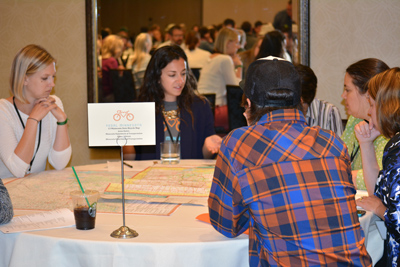
Allison Johnson, research analyst in the Office of Transportation System Management, and Jasna Hadzic, bike planner, talk about the state bicycle map during the PedalMn Bike Conference May 4-5 in Minneapolis. Photo by Sue Roe |
More than 200 bicycle enthusiasts, advocates and supporters kicked off National Bike Month by attending the 2015 PedalMn Bike Conference May 4-5 in Minneapolis. The conference was sponsored by PedalMn, a partnership of agencies and organizations that include MnDOT.
“It was wonderful to be surrounded by all the energetic professionals and advocates from a broad range of perspectives who were willing to share their experiences related to how we are all working towards one common goal of making Minnesota The Bicycle Friendly State," said Tim Mitchell, bicycle and pedestrian coordinator.
Featured speakers were national and state bicycle leaders, including Steve Clark and Liz Cornish Jones, of the League of American Bicyclists; Stephen Regenold, founder of the online magazine GearJunkie.com; and Gabe Klein, who built an agency hailed as a national leader in technology, customer interface and multi-modal innovation.
Minneapolis councilmember Lisa Bender, Rep. Leon Lillie, Rep. Phyllis Kahn and Sen. Scott Dibble also spoke at the conference. Congressman Keith Ellison was featured in a video welcome.
The conference included sessions on how bicycling promotes healthy lifestyles, tourism, economics and the environment. One session, Seniors to Millenials – Reaching Your Demographic, had an overflow crowd. The panel discussed ways to increase bicycling by targeting the cost, safety, convenience, and social engagement needs of all ages.
MnDOT presenters included Nicole Campbell, who talked about the Safe Routes to School program; Liz Walton, who talked about the U.S. bicycle route system; Greg Lindsey, who talked about bicycle counts; and Jasna Hadzic and Allison Johnson, who talked about the state bicycle map.
Assistant Commissioner Tim Henkel facilitated a discussion about equity in bicycling and Commissioner Charlie Zelle moderated a panel discussion by the mayors of Minneapolis, St. Paul, Rochester and Bemidji. Each mayor talked about their city’s success in building bicycle partnerships, infrastructure and culture.
“If we build for ages eight to 80, everyone will have a place to bike and walk,” said St. Paul Mayor Chris Coleman. “If you make it easier to bike, you’ll have more business.”
Minneapolis Mayor Betsy Hodges drew a round of applause when she told the group that her first proclamation as mayor was to declare winter biking day in Minneapolis.
Participants had the opportunity to take guided bike tours of Minneapolis’ Midtown Greenway, Mississippi River parkway and local neighborhoods. The tours helped participants see how neighborhoods connect to destinations and how agency staff work with partners to ensure bicycle projects are successful and achieve broader goals.
The conference is held about every two years. MnDOT originally sponsored the conference, but over the years, more groups became sponsors as the conference’s goal expanded to include health, safety, economic and environmental aspects of bicycling.
Minnesota is named #2 most bike friendly state; sets sights on #1
Minnesota retained its ranking as the second most bike friendly state in the nation this week. The state has consistently placed in the top five since 2008. The League of American Bicyclists issues the rankings annually.
“This ranking signifies that we continue to move in the right direction,” said Tim Mitchell, bicycle and pedestrian coordinator. “We still have some work to do to accomplish our collective goal to become the most bicycle friendly state, but the efforts and leadership of all the agencies that support bicycling show we are continually making progress.”
Minnesota scored less than four points behind Washington, which remained the top ranked state for the eighth year.
Minnesota’s earned its ranking because of its work in legislation and enforcement, policies and programs, infrastructure and funding, education and encouragement, and evaluation and planning. The state was credited for including a bicycle safety emphasis in the Strategic Highway Safety Plan.
Nearly half of Minnesotans rode a bicycle last year, according to the 2014 Omnibus Transportation Survey.
Read more about the state’s ranking or read the news release. |
|
 |
|

|
 |
TABLE of CONTENTS
 |
Library hosts first-ever Artist-in-Residence |
By Marilee Tuite, Research Services and Library

Emily Stover will join the MnDOT Library as an Artist-in-Residence during May and June. Photo courtesy of Coffee House Press |
The MnDOT Library, in partnership with Coffee House Press, is hosting an Artist-in-Residence during May and June. This is part of the Coffee House Press’ ongoing program, CHP In the Stacks, which places authors in temporary artistic residencies in various distinguished libraries and collections. Each resident artist uses the collection to create new work.
The Library is hosting Emily Stover, a St. Paul landscape architect and public artist. She is interested in public works and infrastructure, especially around rivers. She will split her residency between the MnDOT Library and the St. Paul District Library of the U.S. Army Corps of Engineers.
The library will host a brown bag session on June 23, inviting MnDOT employees to hear about Stover’s resulting work. |
 |
|

|
|

|
 |
TABLE of CONTENTS
 |
What’s new on the web |
By Greg Ruhland New and improved approved products site
The approved products site is mobile-optimized and accessible. One of the changes is a new scrollbar at the bottom of data tables, allowing anyone on a mobile device to pan right or left to see a full table, even if it is wider than their screen. Also, products specs/qualifications and contact information are much easier to find at a glance, and navigation is consistent throughout the site. Look over the pages to get a feel for the new format.

The Mississippi River Trail web page has been updated with the newest trail maps. |
Updated Mississippi River Trail maps available
The revamped Mississippi River Trail web pages have the newest trail maps available for download. Information about the trail is also organized more intuitively. A new Plan a Visit page helps visitors prepare each step of their Trail excursion – from getting there to enjoying each trail segment’s parks, locks, dams, communities, and many things to do and see.
Questions? Let Web Team know. Email webteam.dot@state.mn.us. |
 |
|
| |
|



